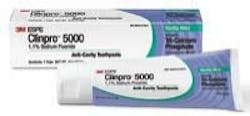Specific milling technique used in manufacturing of TCP
By Ellen S. Neuenfeldt, RDH, BS, Professional Relations Manager, 3M ESPE
Dental caries is a complex disease that involves the continuous processes of remineralization and demineralization. Although it is well documented that fluoride can serve as a catalyst for remineralization, it will not occur unless adequate amounts of calcium and phosphate ions are available.For patients with normal salivary flow, adequate amounts of calcium and phosphate are present to aid in the remineralization process; however, for those patients whose saliva production is compromised and results in poor saliva flow, a low (acidic) pH, and minimal buffering capacity, products that include calcium and phosphate are beneficial in the management of their dental caries infection.There are several calcium phosphate based technologies currently available. One of them is tri-calcium phosphate (TCP), an ingredient that is exclusive to 3M ESPE. To make the combination of fluoride, calcium, and phosphate as effective as possible, a specific milling technique is used during the manufacturing process of TCP. This creates a protective barrier around the calcium, which prevents it from prematurely interacting with the fluoride. If calcium is not protected from fluoride, the two minerals will bind together during storage rendering them ineffective. When TCP comes into contact with the tooth surface and is moistened by saliva, the protective barrier breaks down, making the calcium and phosphate available to join fluoride ions on the teeth. The fluoride and calcium then react with weakened enamel to enhance remineralization.
Dental caries is a complex disease that involves the continuous processes of remineralization and demineralization. Although it is well documented that fluoride can serve as a catalyst for remineralization, it will not occur unless adequate amounts of calcium and phosphate ions are available.For patients with normal salivary flow, adequate amounts of calcium and phosphate are present to aid in the remineralization process; however, for those patients whose saliva production is compromised and results in poor saliva flow, a low (acidic) pH, and minimal buffering capacity, products that include calcium and phosphate are beneficial in the management of their dental caries infection.There are several calcium phosphate based technologies currently available. One of them is tri-calcium phosphate (TCP), an ingredient that is exclusive to 3M ESPE. To make the combination of fluoride, calcium, and phosphate as effective as possible, a specific milling technique is used during the manufacturing process of TCP. This creates a protective barrier around the calcium, which prevents it from prematurely interacting with the fluoride. If calcium is not protected from fluoride, the two minerals will bind together during storage rendering them ineffective. When TCP comes into contact with the tooth surface and is moistened by saliva, the protective barrier breaks down, making the calcium and phosphate available to join fluoride ions on the teeth. The fluoride and calcium then react with weakened enamel to enhance remineralization.
The two dental products currently available with TCP are 3M ESPE Clinpro 5000 Anti-Cavity Toothpaste and 3M ESPE Vanish 5% Sodium Fluoride White Varnish. One in-vitro study of Clinpro 5000 toothpaste concluded that it delivered more high-quality mineral at the surface, and also deep into carious lesions, with superior surface and subsurface remineralization compared to a 5,000 ppm fluoride product. (1) Another in-vitro study found that Clinpro 5000 demonstrated better remineralization when compared to a CPP-ACP containing product (2).As health-care professionals, we have the obligation and opportunity to assist our patients in successfully managing their dental caries infection. This can be accomplished by providing appropriate in-office treatments, and recommending clinically effective take-home products. References
1. Karlinsey RL, Mackey AC, Walker ER, et al. Remineralization potential of 5,000 ppm fluoride dentifrices evaluated in a pH cycling model. J Dent Oral Hyg. 2010;2:1-6.2. Karlinsey RL, Mackey AC, Stookey GK, Pfarrer AM. In vitro assessments of experimental NaF dentifrices containing a prospective calcium phosphate technology. Am J Dent. 2009;22:180-184
1. Karlinsey RL, Mackey AC, Walker ER, et al. Remineralization potential of 5,000 ppm fluoride dentifrices evaluated in a pH cycling model. J Dent Oral Hyg. 2010;2:1-6.2. Karlinsey RL, Mackey AC, Stookey GK, Pfarrer AM. In vitro assessments of experimental NaF dentifrices containing a prospective calcium phosphate technology. Am J Dent. 2009;22:180-184
Ellen Neuenfeldt, RDH, BS



